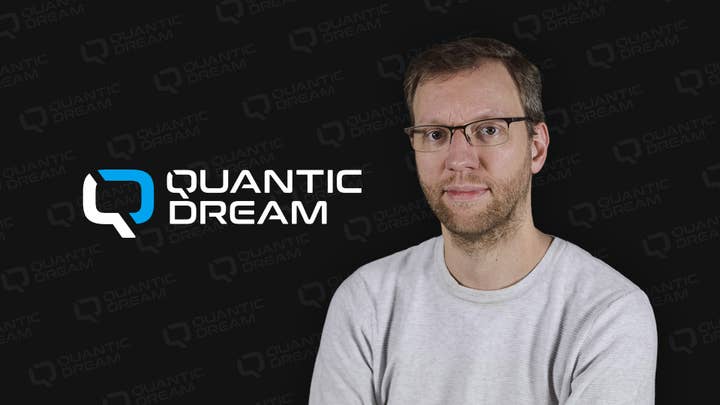How Quantic Dream took control of remote working using Amazon Web Services
Sponsored article: The Heavy Rain and Beyond Two Souls studio explains how it used the cloud to move its teams out of the office
With such fierce competition for talent within the games industry, many studios are exploring ways to welcome remote hires. However, no one could predict that remote working would become a necessity rather than an option in 2020.
Almost overnight, the COVID-19 pandemic scattered teams and prevented access to offices and physical hardware, leaving several unable to work. But many are rising to the challenge, building great player experiences and collaborating with teams from the comfort of their homes. I caught up with French game studio Quantic Dream's CTO Jean-Charles Perrier, to find out more.
Quantic Dream's AAA interactive storytelling games include The Nomad Soul, Indigo Prophecy (Fahrenheit outside the US), Heavy Rain, Beyond: Two Souls and Detroit: Become Human. After NetEase took a minority stake in the studio last year, the investment opened up a number of opportunities.
"We're keen to attract recruits from other countries, and so we'd been thinking about a cloud solution for a long time"
Up to that point, Quantic Dream had been making games exclusively for PlayStation, but has since gone on to broaden its appeal by developing for a wider range of platforms, including PC.
As part of its plans to create more games and grow the team, Quantic Dream were considering launching a recruitment drive that wouldn't be restricted by physical proximity.
"We're keen to expand our potential talent pool and attract recruits from other countries, and so we'd been thinking about a cloud solution for a long time," Perrier explains.

Re-think leads to a reboot
When Europe was hit by COVID-19, these long-term remote working plans suddenly became top priority. By the time the French government implemented lockdown measures in the middle of March, Quantic Dream had already taken the tough decision to temporarily close its Paris headquarters.
This left many of the company's artists, animators, developers, and designers unable to work at all. It wasn't feasible or practical to redistribute the studio's hardware amongst dozens of individual employees' homes. On the contrary, having too many people accessing the in-studio infrastructure remotely could create significant network bottlenecks and risk overwhelming Quantic Dream's systems.
"There's not enough capacity for everyone to be streaming in full 60 FPS 4K from Quantic in our team's hardware set-up, so we decided to provide cloud-based workstations"
Faced with this dilemma and in a race against time, Quantic Dream consulted AWS to find a technical solution that would get the entire studio working and collaborating from home as quickly as possible.
"There's not enough capacity for everyone to be streaming in full 60 FPS 4K from Quantic in our team's hardware set-up, so we decided to provide cloud-based workstations to avoid loading pressure on our own hardware," Perrier adds.
Quantic Dream's solution was to build its own client and serverless backend using Amazon API Gateway and AWS Lambda, facilitating connections to cloud workstations running on Amazon EC2 G4dn Instances. The team tested a number of streaming protocols including RDP, Parsec, and Teradici, before opting for Amazon's NICE DCV.
When the client connects to the backend, an AWS Lambda function will find the right workstation for the user, start it if it has been stopped, query for its IP address, and automatically connect the user to the workstation using NICE DCV streaming, a remote display protocol that offers a secure way to deliver remote desktops and application streaming from any cloud or datacenter to any device.

"We chose NICE DCV software for the high resolution, fast, low-latency streaming we need to test a game and provide good feedback to artists working with 3D asset creation software," Perrier says. "NICE DCV also supports dual-screen and allows USB access. That was a key point for us because our artists work on graphics tablets, like the Wacom, or other very specific hardware.
"The architecture this time around works well, with the result much better than anyone anticipated. The majority of employees and collaborators are able to work remotely in acceptable to very good conditions, depending on the quality of their internet connection and the specifics of their role."
Securing a way to work remotely
With so many employees and collaborators working remotely on different computers and home networks, securing project assets and intellectual property was a crucial consideration.
"Using NICE DCV, contractors only worked on cloud-based virtual desktops, with tightly controlled access to assets, so there were no data leaks"
"When there are multiple people working from home, we have no control over how secure their home machines are," Perrier says. "For example, there might not be a robust enough anti-virus software installed, like there is at our headquarters."
Cloud workstations proved to be the ideal solution to grant access to resources and code securely. Artists, designers and animators have access only to the stream, meaning they cannot download assets or share them.
Perrier explains: "The end user has access to only the image or video being streamed to their local workstation, rather than the actual asset, which is a great security feature.
"With regard to data security and how we work with third parties and sub-contractors, the AWS cloud has another great benefit for us. Using NICE DCV, contractors only worked on cloud-based virtual desktops, with tightly controlled access to assets, so there were no data leaks."
Although it was set up under intense time pressure, the switch to cloud workstations made it possible for the studio to work remotely in a fast, efficient, and secure way. In fact, things have worked out far better than Jean-Charles Perrier hoped and, longer term, the plan is to move everyone to the cloud.
"We're all quite surprised by the result," he says. "Many of our employees and collaborators say it's almost as though they're working at the Quantic studio, which is great to hear."
Arni Birgisson is senior game tech developer advocate at Amazon Web Services, leading its Game Tech developer advocacy efforts in Europe, Middle East and Africa. With over 20 years of industry experience, his expertise covers a broad spectrum of topics ranging from mobile game backends and cloud infrastructure, to system management and networking. To learn more about how you can run and operate games at scale, visit the AWS Game Tech website.